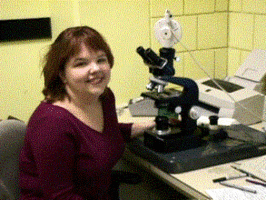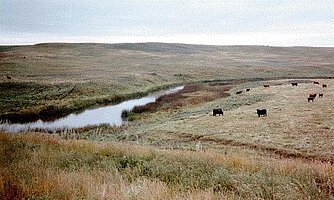The Periphyton in the Sheyenne River, North Dakota

Megan A. Jaskowiak received a B.A. from Northern Kentucky University in 1997. Megan's Ph.D. dissertation in Botany has been accepted in December 2002 at North Dakota State University. Currently, she is a post-doctoral Fellow in the Department of Biological Sciences at NDSU. She hopes to continue her research in community ecology within the framework of water quality. Also, she is interested in expanding her research into the areas of diatom taxonomy and systematics. She looks forward to a career which involves both teaching and research.
Fellow: Megan A. Jaskowiak,Department of Botany, NDSU
Advisor: Marvin W. Fawley, Professor of Biology, NDSU
Matching Support: North Dakota State Department of Health, Bismarck; NDSU central administration
Degree Progress: Ph.D. completed in December 2002
The Periphyton in the Sheyenne River, North Dakota
Aquatic systems with flowing water have very dynamic environments that produce complex periphytic algal communities. These communities are sensitive to changes in their environment. Therefore, changes in these communities can be used in water quality assessment. Historically, problems have been associated with this use of these algae. Some of these problems have been solved. In current research, these algal communities are used to monitor the quality of these systems. However, some problems still exist. These problems are that no standard sampling method has been established, identification of these organisms is difficult and requires extensive training, and the identification in existing studies may not be either consistent or correct. However, even with these difficulties, scientists have found that these communities can still be used to assess the conditions of the environment. Therefore, if the problems are overcome, then these communities would provide an accurate biological assessment of water quality.
The periphytic algae of the Sheyenne River in North Dakota were examined. This research consisted of several different studies. In the first study the distribution of the periphytic algae was examined. In the second, the distribution of the periphytic algae was correlated to changes the environmental conditions. In the third study, two species of diatoms that could not be identified to species were described as new species. Also, the differences between natural substrates and artificial substrates were compared using canonical correspondence analysis (CCA). The relative abundance data from these studies were compared to presence/absence data using multiple dimensional scaling (MDS). Last, the effects of Lake Ashtabula, a reservoir, on the down river algal populations were examined.
The objectives of the first study were to identify the periphytic algae in the Sheyenne river and to examine the distribution of the periphytic algae throughout the river. These data will be used as a baseline for further ecological studies. Altogether 132 artificial substrate samples were collected. Two hundred twenty-one periphytic algal taxa were identified and the relative abundance of each taxon was determined. Several potentially new species were detected. The distribution of periphytic algal taxa was closely examined for both seasonal and spatial patterns.
In the second study, the objective was to determine which environmental variable correlate with the distribution patterns of the periphytic algae in the Sheyenne River. Direct ordination, a type of multivariate statistics, was used. Nineteen environmental variables were used in the analysis. This analysis found that the variables that explained the most variance in the periphytic algal communities were magnesium, manganese, chloride, calcium, nitrite-nitrate, sulfate and pH (p<0.05).
During the examination of the periphytic algae in the Sheyenne River, 59 taxa could not be identified to species. Two of these organisms were originally identified as Nitzschia sp. 4 and Nitzschia sp. 5. The objective of the third study was to determine if these organisms are new species and to describe them. Nitzschia sp. 4 was compared with its possibly closest related species, Nitzschia filiformis. Nitzschia sp. 5 was compared with its possibly closest related species, Nitzschia amphibia and seimrobusta. Nitzschia sp. 4 and Nitzschia sp. 5 are differ from these described species. Therefore, Nitzschia sheyennensis Jaskowiak sp. nov. and Nitzschia dakotensis Jaskowiak sp. nov. were described from the periphytic algae of the Sheyenne River, North Dakota.
This research also included a comparison of the natural substrates and artificial substrates and a comparison of the use of presence/absence data versus relative abundance data in CCA. Natural substrate communities appear to be quite different from the artificial substrate communities. These differences include several species which were not found at all on the artificial substrates. An example of these additional species is the diatom, Navicula mutica. The artificial substrates appear to be a better representation of some natural substrates, e.g., rocks. Presence/absence data seem to produce the same results statistically as the relative abundance data. Further study may show that presence/absence is a viable type of species examination for water quality studies.
The effects of Lake Ashtabula on the down river algal populations are considerable. Studies have shown that sites within a river have a large year to year variation. The year to year variation within the sites in the Sheyenne River is high. However, the effects of Lake Ashtabula have a greater effect. Several species of algae that are common in the sites upriver from the reservoir are not at the sites down river. Also, species that are usually found in lakes are in the down river sites, but are not upriver from the reservoir. Close examination of the species will help determine if this effect is due to nutrient influx from the reservoir or from effects of erosion caused by the controlled flow of the river.
These studies were the first investigation of the periphytic algae in the Sheyenne River. This research found a diverse community that is in part controlled by nine environmental variables. Also, the growth of these algae is affected by year to year changes and by the influence of Lake Ashtabula. In this research, quite a few taxa could not be identified to species. Description of these new species will help to use the periphytic algae for water quality assessment. These results of this research provide the information needed to use the periphytic algae of the Sheyenne River for water quality assessment.
Relevant Publications of M. A. Jaskowiak and the Fawley Research Group
Reports and Book Chapters
Fawley, M. W., K.A. Phillips and M. A. Jaskowiak, An Analysis of the algal communities of the Sheyenne River, North Dakota, potentially affected by the Devils Lake emergency outlet, report submitted to the U. S. Army Corps. of Engineers, 2000. [Available from: Dr. M.W. Fawley, Department of Biology, NDSU, Fargo, ND 58105]
Publications:
Jaskowiak, M. A., Fawley, K. P. and Fawley, M. W. 2002. Nitzschia sheyennensis and Nitzschia dakotensis, two new species of Bacillariophyta from the Sheyenne River, ND.
(in preparation).
Jaskowiak, M. A., Fawley, K. P. and Fawley, M. W. 2002. The effects of Lake Ashtabula, a reservoir, on the distribution of algae in the Sheyenne River, ND. (in preparation).
Jaskowiak, M. A., Fawley, K. P. and Fawley, M. W. 2002. An assessment of algal communities from the Sheyenne River, ND using two statistical methods. (in preparation).
Jaskowiak, M. A., Fawley, K. P. and Fawley, M. W. 2002. A survey of the periphytic algae in the Sheyenne River, ND. (in preparation).
Phillips, K. A., Jaskowiak, M. A. and M. W. Fawley. 2002. A survey of the phytoplankton in the Sheyenne River, ND. (in preparation).
Presentations
Jaskowiak, M. A., Phillips, K. A. and M. W. Fawley. 2001. Three possible new species of Nitzschia Hassall (Bacillariophyta) from the Sheyenne River, ND. poster presentation at the Phycological Society of America Meeting in Estes Park, CO.
Jaskowiak, M. A., Phillips, K. A. and M. W. Fawley. 2000. An investigation using canonical correspondence analysis (CCA)of the environmental variables that shape the periphytic communities in the Sheyenne River, ND. A poster presentation at the North American Benthological Society Meeting, Keystone, CO.
Jaskowiak, M. A., Phillips, K. A. and M. W. Fawley. 1999. The periphytic algae in the Sheyenne River, ND, Preliminary Results. A poster presentation at the North American Benthological Society Meeting, Duluth, MN.


Marvin W. Fawley
Botnany, NDSU


